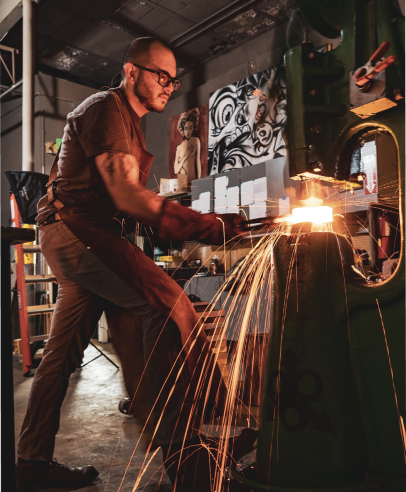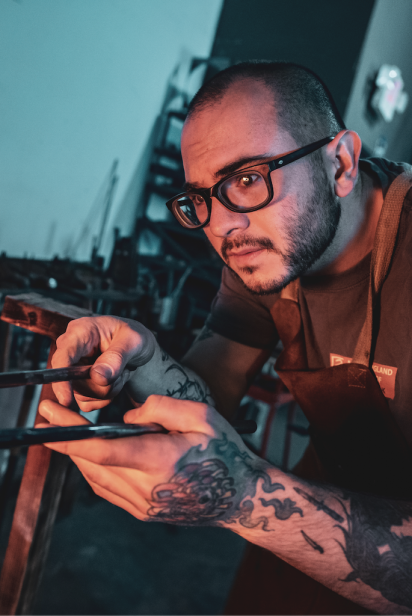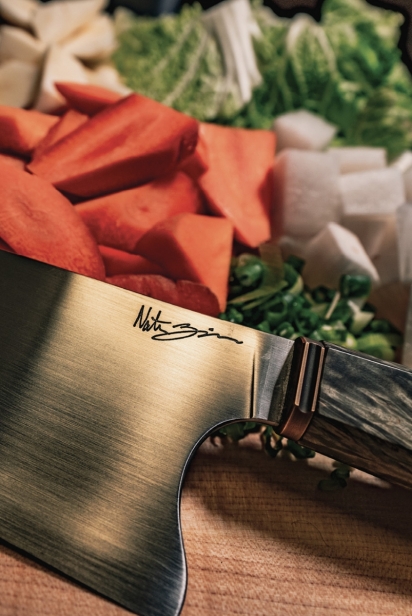The Story Behind the Blade
The correct tools are imperative when it comes to cooking even the simplest of dishes, and the perfect knife is the shining star of any chef’s culinary arsenal. Lucky for local connoisseurs, Nate Zimmerman of ZimKnives is continually producing high quality and visually stunning knives out of his Riverwest workshop.
Prominent Milwaukee restaurants like Ardent and Birch & Butcher boast his designs, enforcing that these culinary giants hold not only the quality of their cuisine but the integrity of their tools to a higher standard. Working with mediums like damascus steel provides Zimmerman the chance to reveal his playful nature by experimenting with different blade patterns and unique materials for eye-catching handles.
Each and every knife that comes out of his shop is meticulously thought out and tailored to reach his ideals of superiority. “If you buy a handmade knife of any sort it is going to perform,” Zimmerman explains. “It’s going to hold an edge, it’s going to cut better; far better than any production knife you’ll find out there.”Zimmerman began his craft by producing stock removal knives. This process starts by cutting a piece out of a single sheet of steel, hand-grinding and sharpening, giving birth to a reliable blade. After mastering this technique, he called on the expertise of other knifemakers and decided to transition into the art of forging.
Forging is a process in which multiple layers of steel are stacked and melted together with insanely high heat. The result is one cohesive mass (or billet), which is then pounded with a hammer to the correct thickness and shape. This layering provides the opportunity to experiment with steel of different carbon percentages, which enforces the integrity of the blade. “If you take a piece of high carbon steel and you put a couple pieces of low carbon steel on the outside, it’ll make the knife way stronger because soft steel will bend rather than breaking, so that holds the hard steel together,” Zimmerman says. Knives made in this method are time consuming and take a great deal of expertise, but produce a result unlike any other.
Zimmerman had only forged two knives before he made his television appearance on “Forged in Fire” a blade-making competition airing on the History channel. “I was supremely confident that I could do well on it, having never picked up a hammer or forged anything in my life. So I applied for the show and then I bought a forge and was gifted an anvil from a good friend. Then I went on the show and forged my third knife on national television.” It was a learning experience for Zimmerman, “I made a knife-shaped object that was full of cracks because I didn’t understand the heat treating process very well at that point, but I had a really excellent experience and met a lot of really cool people. When I got back, I vowed to learn to do it the right way.”
And learn he did, when he received a scholarship to the New England School of Metalwork in Auburn, Maine. “I took a course on how to forge chef knives with a man named Nick Rossi, who has since become a really important mentor in my life,” Zimmerman says. As he pursued education in kitchen cutlery, Zimmerman aligned his artistic practice with his love of food.
“I have a first generation Italian-American mother and she cooked every night; if you didn’t like the food you went hungry,” he recalls. “The main reason that I got into making chef knives specifically was because I really enjoy cooking and having a nice knife gives you an excuse to cook,” Zimmerman says. One of his favorite dishes to make is Chanko Nabe, otherwise known as Sumo Wrestler Stew. “Living in Wisconsin, the weather lends itself to soups very nicely.” This “throw everything in a pot” stew features tasty tidbits like fish balls, pork meatballs and a variety of vegetables.
Even though he loves experimenting in the kitchen and using his own specified tools, Zimmerman celebrates the culinary scene in Milwaukee and jumps at any chance to tuck into a good meal. “I really do love the recognition that Milwaukee chefs are getting lately, there’s so much talent in this city and so much amazing food to explore,” he says.
Zimmerman can’t help but look forward to the future and make his mark on the city he loves. “I want to be able to provide quality, custom-made tools for the hardworking chefs of Milwaukee to make their jobs easier… and I have a secret ultimatum. If all of the local chefs like you, you get treated really well wherever you go!” Someday, Zimmerman hopes his dream of providing artisanal knives for each and every restaurant of Milwaukee will come true, and his hard work and artistic vision will lie behind every delicious bite.






